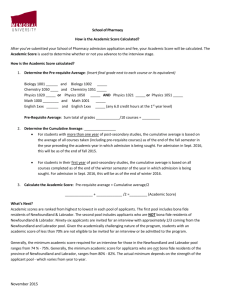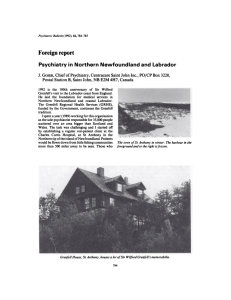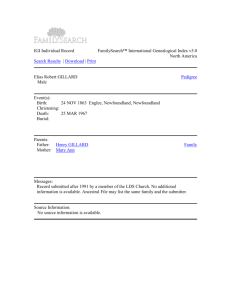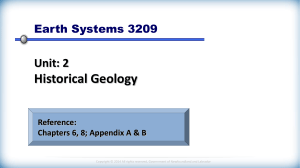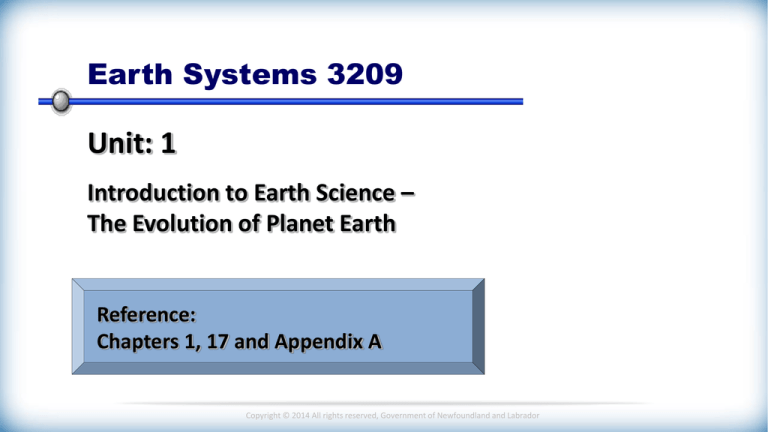
Earth Systems 3209
Unit: 1
Introduction to Earth Science –
The Evolution of Planet Earth
Reference:
Chapters 1, 17 and Appendix A
Copyright © 2014 All rights reserved, Government of Newfoundland and Labrador
Unit 1:
Topic 2.3
Formation of Earth (Geosphere)
Focus on . . .
describing how Earth (Geosphere) segregated into layers.
identifying that segregation was influenced by radioactive
decay, collision of particles, gravity and density.
Copyright © 2014 All rights reserved, Government of Newfoundland and Labrador
Solar Nebula Hypothesis: Overview
To understand the origin of Earth, we must focus
on how Earth formed billions of years ago. Earth
formed as a direct result of the “Solar Nebula
Hypothesis”, which states, “a great cloud of gas
and dust shrank under its own gravitation and
transformed into the planets and natural satellites
that make up the present solar system”
Text Reference:
pages 19 – 20
Copyright © 2014 All rights reserved, Government of Newfoundland and Labrador
Early Earth
It is thought that Earth was not
always layered as it is today
Some scientist suggest that Earth
was a lot like the moon in
appearance billions of years ago
The composition of the ancient Earth
was thought to be the same throughout.
It separated later in Earth’s history
Copyright © 2014 All rights reserved, Government of Newfoundland and Labrador
Segregation of Earth (Geosphere)
Shortly after Earth formed, the interior
segregated and took on a layered structure
Heat generated from the collision of
particles and the decay of radioactive
isotopes produced heat and was
responsible for melting Earth’s interior
Copyright © 2014 All rights reserved, Government of Newfoundland and Labrador
Segregation of Earth (Geosphere)
Gravitation caused great streams of hot
heavy liquids to move toward Earth’s
center and melted the lighter rock material
forcing it to the surface
This sorting of material by density
early in Earth’s history, is still occurring
today, but on a smaller scale
Gases are released from Earth’s interior
through volcanoes
Copyright © 2014 All rights reserved, Government of Newfoundland and Labrador
Segregation of Earth (Geosphere)
Crust
Inner Core
Outer Core
Mantle
The heavier material (nickel and iron) which
concentrated close to Earth’s center formed the
inner and outer core
The lighter and less dense material which moved
upwards closer to the surface formed Earth’s crust
The material in between formed earth’s mantle
and continues to separate today
Copyright © 2014 All rights reserved, Government of Newfoundland and Labrador
Segregation of Earth (Geosphere)
Atmosphere
Hydrosphere
Geosphere
Atmosphere and oceans formed as a result of the
gases given off by volcanic out gassing throughout
Earth’s history
This will be discussed in another presentation
Copyright © 2014 All rights reserved, Government of Newfoundland and Labrador
Example 1:
Which factors were most responsible for the segregation
of Earth into layers?
(A) Earth’s rotation, meteorite impact, radioactive decay
(B) Earth’s rotation, volcanic outgassing, density
(C) gravity, volcanic outgassing, meteorite impact
(D) gravity, radioactive decay, density
Copyright © 2014 All rights reserved, Government of Newfoundland and Labrador
Example 2:
What is thought to be the primary reason for Earth’s
internal temperature remaining higher than expected?
(A) friction caused by the rubbing of plates
(B) gravitational pull from the moon
(C) increasing sedimentary layers on the surface
(D) radioactive decay of unstable elements
Copyright © 2014 All rights reserved, Government of Newfoundland and Labrador
Your Turn . . .
Take the time and complete the following question . . .
(Solution to follow)
Questions:
How does the solar nebular hypothesis explain
the segregation of the geosphere into layers?
Copyright © 2014 All rights reserved, Government of Newfoundland and Labrador
Solutions . . .
Questions:
How does the solar nebular hypothesis explain the segregation
of the geosphere into layers?
Billions of years ago, the decay of radioactive elements coupled with
heat generated by the colliding of particles, caused Earth’s interior to
melt.
This allowed a differentiation of Earth’s interior based on density.
The denser elements, nickel and iron, would sink to the interior while
the lighter rocky components (silicates) floated toward the surface.
This segregation by density is thought to still occur today on a smaller
scale and was responsible for the apparent layering of Earth’s interior
into layers of material with different physical properties.
Copyright © 2014 All rights reserved, Government of Newfoundland and Labrador
NOTE:
Be sure to
“refer to page
19 - 20 in
text. Second
paragraph top
left of!!
Additional Question and Solution:
Describe the process that could lead to the segregation of layers
within a newly-formed planet.?
A newly-formed planet would have a homogeneous solid interior that is the same
throughout. Over time the planet would experience numerous impacts from
meteoroids and asteroids. This would cause the particles within the planet to
collide and heat up as a result of friction. In addition, heat may result when
radioactive elements, common in space rocks, decay to become stable elements.
The resulting heat would build up within the planet and eventually cause the
interior to melt. Heavier, more dense elements would move toward the center of
the planet and the lighter, less dense elements would move toward the surface of
the planet. This process would continue for extended periods of time and result in
the planet becoming segregated into layers according to the density of the
material that makes up the planet.
Copyright © 2014 All rights reserved, Government of Newfoundland and Labrador
Summary . . .
Overview of Points covered:
When describing how Earth segregated, include the following main points:
Primitive Earth was one homogeneous solid sphere.
Interior heated up and melted as a result of;
1) collision of particles and 2) decay of radioactive elements.
Gravity caused the more dense materials (nickel and iron) to move
toward the center of Earth which formed the inner and outer cores.
Lighter materials (silicates) were forces toward the surface and formed
the crust.
Material in between formed a layer called the mantle. This layer is still
segregating today.
Throughout the segregation process, volcanic gases escaped which
eventually formed the atmosphere and the hydrosphere.
Copyright © 2014 All rights reserved, Government of Newfoundland and Labrador


